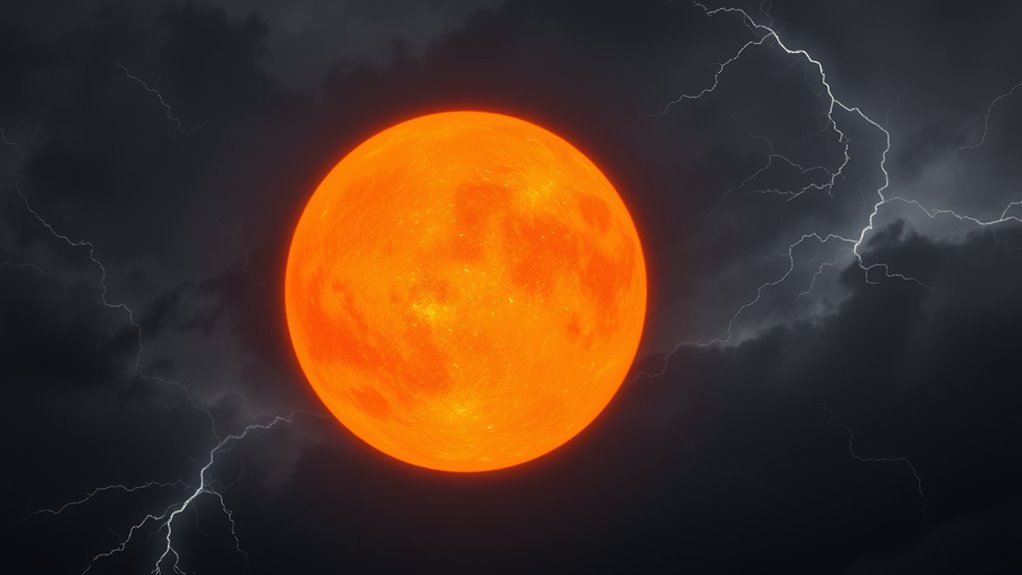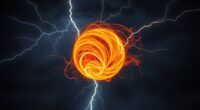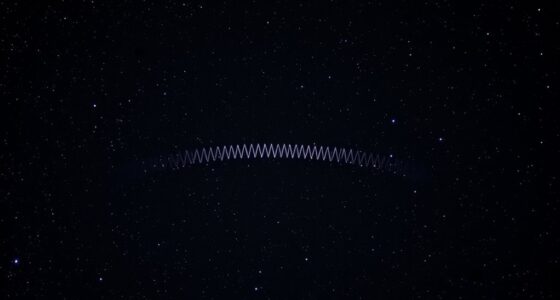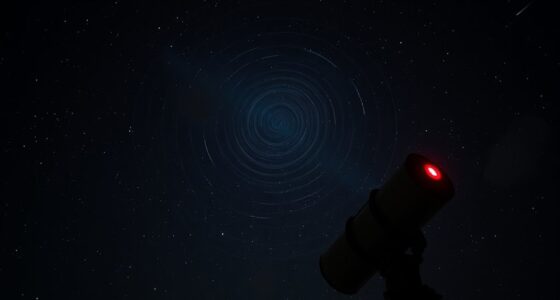Ball lightning forms through the interaction of atmospheric electricity and plasma physics. During thunderstorms, charge buildup creates intense electric fields, which ionize air molecules and produce plasma. This plasma can self-organize into luminous, spherical shapes thanks to electromagnetic forces and magnetic stabilization from Earth’s magnetic environment. These stable plasma spheres can persist for seconds or more before dispersing. To understand the complex physics behind these fleeting phenomena, continue exploring the fascinating science driving ball lightning‘s formation.
Key Takeaways
- Ball lightning forms when intense atmospheric electric fields ionize air molecules, creating a stable plasma sphere.
- The plasma’s electromagnetic properties enable energy confinement and shape stability during thunderstorms.
- Interaction with Earth’s magnetic field produces forces that help sustain and stabilize the luminous sphere.
- Local atmospheric conditions influence plasma formation, energy retention, and the phenomenon’s visibility.
- Ongoing research suggests electromagnetic stabilization mechanisms are key to the longevity and autonomous movement of ball lightning.
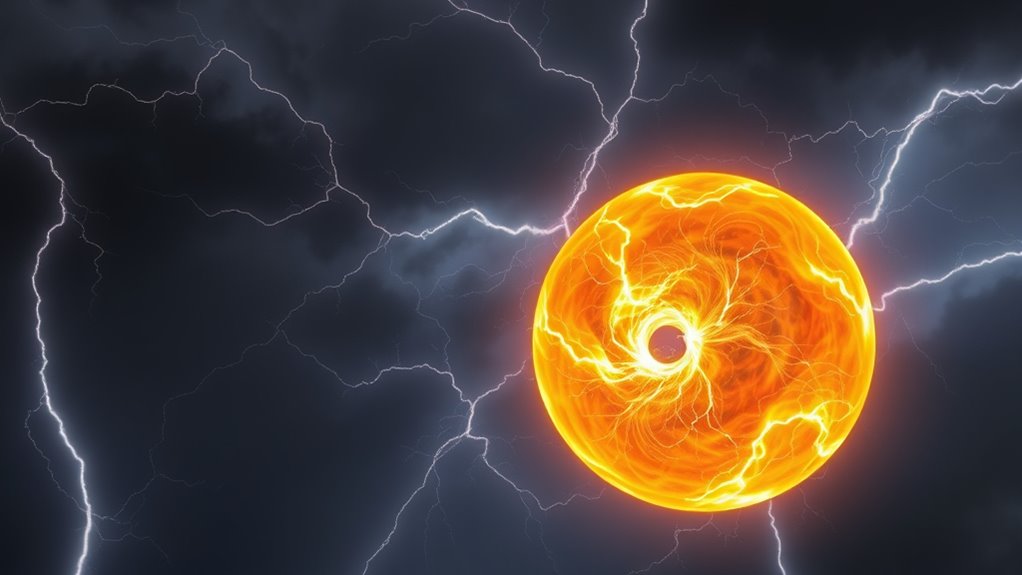
Ball lightning remains one of the most mysterious phenomena in nature, puzzling scientists for centuries. When you witness a glowing, floating sphere during a thunderstorm, you’re observing a complex interplay of plasma dynamics and atmospheric electricity. While no one fully understands how these luminous orbs form, recent advances suggest that plasma behavior plays a central role. The key lies in how electrical energy from storm clouds interacts with the Earth’s atmosphere, creating conditions ripe for the emergence of ball lightning.
During a thunderstorm, atmospheric electricity becomes intensely active. The build-up of charge within storm clouds generates powerful electric fields, which can extend downward toward the ground. These fields can cause ionization of the surrounding air, stripping electrons from molecules and forming plasma—a hot, ionized state of matter that conducts electricity. When this plasma is confined in a stable, spherical shape, it appears as the glowing ball seen in ball lightning. The plasma’s unique dynamics, such as how it sustains itself and maintains its shape, are essential pieces of the puzzle. Researchers believe that the plasma’s electromagnetic properties allow it to trap energy and persist longer than typical lightning flashes, which last only milliseconds.
Atmospheric electric fields cause ionization, forming plasma spheres that sustain themselves through electromagnetic forces, resulting in glowing ball lightning.
Furthermore, the interaction between plasma and atmospheric electricity may produce magnetic fields that help stabilize the ball. As the plasma interacts with the Earth’s magnetic environment, it can create a self-sustaining loop, preventing the ball from disintegrating instantly. This stabilization process involves complex plasma dynamics, where charged particles within the sphere move in such a way that they generate magnetic forces counteracting dispersal. This balance allows the phenomena to last for several seconds or more, giving it the appearance of a floating, autonomous sphere.
Recent studies also suggest that the behavior of plasma in the presence of atmospheric electric fields is crucial for understanding how these luminous spheres form and persist. You might also consider that the formation of ball lightning involves more than just electrical phenomena; local atmospheric conditions—such as humidity, temperature, and air composition—may influence plasma behavior. Variations in these factors could affect how plasma is generated, how it maintains its energy, and whether it becomes visible as a luminous sphere. The interaction between plasma dynamics and atmospheric electricity creates a delicate, transient state that is difficult to reproduce or predict, but recent studies are bringing us closer to understanding it.
In essence, ball lightning forms through a complex dance of plasma dynamics driven by atmospheric electricity. As electrical energy is released during thunderstorms, it can generate plasma spheres stabilized by magnetic and electric forces. While many details remain elusive, ongoing research continues to uncover the core physics behind this mesmerizing phenomenon, revealing a fascinating aspect of our natural world.
Frequently Asked Questions
Can Ball Lightning Be Safely Observed During Thunderstorms?
You shouldn’t attempt to observe ball lightning during thunderstorms, as electromagnetic interference can pose risks. While it’s fascinating, it’s unpredictable and potentially dangerous. Follow lightning safety protocols, like staying indoors and away from windows, to protect yourself. If you’re curious, consider watching from a safe distance or through scientific recordings. Remember, your safety is more important than witnessing rare phenomena firsthand during a storm.
How Long Does Ball Lightning Typically Last?
You might wonder about the lifespan of ball lightning, and it usually lasts just a few seconds. The ball lightning duration varies, but most sightings report it lingering for about 2 to 5 seconds. Sometimes, it can persist longer, up to 10 seconds, before disappearing or dissipating. Although brief, the lifespan of ball lightning can be unpredictable, making it a fascinating yet elusive phenomenon to observe during thunderstorms.
Is Ball Lightning Affected by Electromagnetic Fields?
Thinking about how ball lightning behaves is like watching a kite dance in a storm—you notice the unpredictable movements. Electromagnetic influence plays a big role here; it affects how the ball interacts with nearby fields. Field interactions can cause it to change direction or even dissipate. So, yes, ball lightning is sensitive to electromagnetic fields, which can alter its path or stability, making it a fascinating phenomenon influenced by electromagnetic forces.
Can Ball Lightning Occur Indoors?
You might wonder if ball lightning can occur indoors. While it’s rare, some indoor phenomena could resemble ball lightning, especially during thunderstorms. Controlled experiments aim to replicate and study these conditions, helping scientists understand their formation. However, genuine ball lightning indoors remains elusive and unpredictable. If you’re curious, always stay safe during storms, and remember that research continues to uncover how these mysterious phenomena might appear in enclosed spaces.
Are There Practical Applications for Understanding Ball Lightning?
Did you know that understanding ball lightning could revolutionize energy storage? Exploring ball lightning theories might lead to breakthroughs in creating safer, more efficient power sources. You could see advancements in technological innovations like wireless energy transfer or lightning-resistant electronics. By studying this phenomenon, you *uncover* new possibilities for harnessing natural energy, making your world safer and more sustainable. So, understanding ball lightning holds exciting potential for practical, real-world applications.
Conclusion
Now that you understand how ball lightning forms, you’ll appreciate its mysterious beauty. Did you know that this rare phenomenon appears less than once in every 10,000 thunderstorms? This rarity makes it even more fascinating. With new physics breakthroughs, scientists are getting closer to fully understanding it. So, next time you see a lightning storm, remember there’s still much to discover about these glowing orbs that have puzzled us for centuries.
